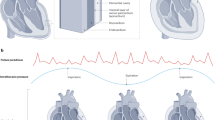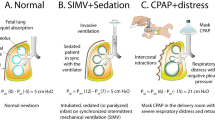Abstract
Pericardial tamponade associated with central catheters is often lethal, unless promptly identified. We report our experience with two infants who suffered this complication but were successfully resuscitated. In each case, associated radiographs showed the tip of the central catheter beyond the superior vena cava–right atrium (SVC–RA) junction. Identifying the clinical triad of (1) sudden cardiovascular collapse unresponsive to usual resuscitative measures, (2) thoracic transillumination not suggestive of air leak, and (3) unexpected resistance to external cardiac compression led to the working diagnosis of pericardial tamponade and therapeutic pericardiocentesis. Prompt recovery followed. Central catheters within the RA seem prone to cause pericardial tamponade.
This is a preview of subscription content, access via your institution
Access options
Subscribe to this journal
Receive 12 print issues and online access
$259.00 per year
only $21.58 per issue
Buy this article
- Purchase on Springer Link
- Instant access to full article PDF
Prices may be subject to local taxes which are calculated during checkout
Similar content being viewed by others
References
Hogan MJ . Neonatal vascular catheters and their complications Radiol Clin North Am 1999 37: 1109–25
Leipala JA, Petaja J, Fellman V . Perforation complications of percutaneous central venous catheters in very low birth weight infants J Paediatr Child Health 2001 37: 2 168–71
Rogers BB, Berns SD, Maynard EC, Hansen TW . Pericardial tamponade secondary to central venous catheterization and hyperalimentation in a very low birth weight infant Pediatr Pathol 1990 10: 5 819–23
Gad Bar-Joseph, Galvis AG . Perforation of heart by central venous catheters in infants: guidelines to diagnosis and management J Pediatr Surg 1983 18: 3 284–7
Goutail-Flaud MF, Sfez M, Berg A et al. Central venous catheter–related complications in newborns and infants: a 587-case survey J Pediatr Surg 1991 26: 6 645–50
Nadroo AM, Lin J, Green RS, Magid MS, Holzman IR . Death as a complication of peripheral inserted central catheters in neonates J Pediatr 2001 138: 599–601
Opitz JC, Toyama W . Cardiac tamponade from central venous catheterization: two cases in premature infants with survival Pediatrics 1982 70: 1 139–40
Beattie PG, Kuschel CA, Harding JE . Pericardial effusion complicating a percutaneous central venous line in a neonate Acta Paediatr 1993 82: 105–107
Wirrell EC, Pelausa EO, Allen AC, Stinson DA, Hanna BD . Massive pericardial effusion as a cause for sudden deterioration of a very low birth weight infant Am J Perinatol 1993 10: 6 419–23
Fioravanti J, Buzzard CJ, Harris JP . Pericardial effusion and tamponade as a result of percutaneous silastic catheter use Neonatal Netw 1998 17: 5 39–42
Jacobson Z, Strom J . Pericardial tamponade complicating central venous catheterization in an infant with very low birth weight: the role of echocardiography in diagnosis and treatment Heart Dis 1999 1: 3 133–5
Kabra NS, Kluckow MR . Survival after an acute pericardial tamponade as a result of percutaneous inserted central venous catheter in preterm neonate Indian Pediatr 2001 68: 7 677–80
Van Ditzhuyzen O, Ronayette D . Cardiac tamponade after central venous catheterization in a newborn infant Arch Pediatr 1996 3: 5 463–5
Scharf J, Rey M, Schmiedl N, Stehr K . Pericardial tamponade as a complication of the use of peripheral percutaneous silastic catheters Klin Padiatr 1990 202: 57–9
Aiken G, Porteous L, Tracy M, Richardson V . Cardiac tamponade from a fine silastic central venous catheter in a premature infant J Paediatr Child Health 1992 28: 325–7
Keeney SE, Richardson CJ . Extravascular extravasation of fluid as a complication of central venous lines in the neonate J Perinatol 1995 15: 284–8
Bargy F, Barbet P, Houette G . The pericardium of the newborn infant. Anatomic and radio-anatomic study with the view towards better positioning central catheters in the superior vena cava Bull Assoc Anat (Nancy) 1986 70: 47–9
Author information
Authors and Affiliations
Rights and permissions
About this article
Cite this article
Schulman, J., Munshi, U., Eastman, M. et al. Unexpected Resistance to External Cardiac Compression may Signal Pericardial Tamponade. J Perinatol 22, 679–681 (2002). https://doi.org/10.1038/sj.jp.7210815
Published:
Issue Date:
DOI: https://doi.org/10.1038/sj.jp.7210815
This article is cited by
-
Factors affecting survival in pediatric cardiac tamponade caused by central venous catheters
Journal of Anesthesia (2015)



